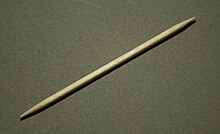Toothpick


A toothpick is a small stick of wood, plastic, bamboo, metal or other substance used to remove detritus from the teeth, usually after a meal. A toothpick usually has one or two sharp ends to insert between teeth. They can also be used for picking up small appetizers (like cheese cubes or olives) or as a cocktail stick.
American wooden toothpicks are cut from birch wood. Logs are first spiral cut into thin sheets, which are then cut, chopped and milled into the individual toothpicks.[1] Maine is the leading producer of toothpicks for the United States.
History
The toothpick has been around longer than our species. The skulls of Neanderthals, as well as Homo sapiens, have shown clear signs of having teeth that were picked with a tool.[2]
It is the oldest instrument for dental cleaning. Toothpicks are well-known in all cultures. Before the toothbrush was invented, one cleaned one's teeth with hard and soft dental woods. Toothpicks made of bronze have been found as burial objects in prehistoric graves in Northern Italy and in the East Alps. It was also well-known in Mesopotamia.
There are delicate, artistic examples made of silver in antiquity, as well as from mastic wood with the Romans.
In the 17th century toothpicks were luxury objects similar to jewellery items. They were formed from precious metal and set with expensive stones. Frequently they were artistically stylized and enameled.
The first toothpick-manufacturing machine was patented in 1872, by Silas Noble and J. P. Cooley.[3]
Nowadays other means of dental hygiene are preferred like the dental floss and toothbrushes, but the usefulness of the toothpick is apparent in the fact that the plastic version of this device is a firm component of the Swiss Army knife.
See also
Further reading
- Petroski, Henry (2007-10-16). The Toothpick: Technology and Culture. Knopf. ISBN 978-0307266361.
Notes
- ^ How It's Made: "Toothpicks; acrylic bathtubs; helicopters; beer." The Discovery Channel.
- ^ Christy G. Turner II, “Interproximal Grooving of Teeth: Additional Evidence and Interpretation,” Current Anthropology 29, no. 4 (1988), 664-65.
- ^ History of the Toothbrush and Toothpaste
